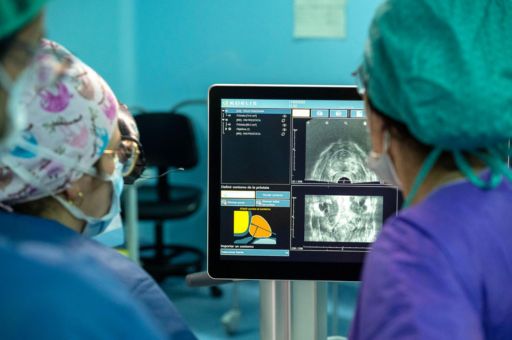The new 3D system makes it possible to perform more accurate, less invasive and more precise biopsies.
Son Llàtzer University Hospital has become the first public hospital in the Balearic Islands to have an innovative Koelis Trinity 3D prostate mapping system, a cutting-edge technology that allows for more accurate and less invasive biopsies.
This equipment fuses in real time the images obtained by ultrasound and magnetic resonance imaging (MRI) and generates an accurate three-dimensional volumetric map of the prostate, which makes it easier to detect and address suspicious lesions.
This advanced system enables precise localisation of the suspicious area to optimise the accuracy of the puncture and reduce the need for multiple tissue extractions. In addition, it enables perineal biopsies with a minimally invasive procedure and rapid patient recovery.
TDB keeps you informed. Follow us on: Facebook, Twitter and Instagram
Son Llàtzer, the first public hospital in the Balearic Islands to incorporate a 3D prostate cartographic system
The main benefits for the patient are as follows:
More accuracy in diagnosis: it makes it possible to detect suspicious lesions more reliably. This reduces the number of false negatives and facilitates the early identification of prostate cancer.
More accurate diagnosis: it allows more reliable detection of suspicious lesions. This reduces the number of false negatives and facilitates the early identification of prostate cancer.
Less discomfort and lower risk of complications: as a minimally invasive procedure, pain, risk of infection and recovery time are reduced compared to conventional biopsies.
Personalised follow-up: the possibility of superimposing images at different times allows specialists to monitor the patient’s evolution and adapt the treatment individually.
Reduction of unnecessary biopsies: in some cases, if the images obtained do not raise doubts, further biopsies can be avoided, reducing the emotional and physical burden on the patient.
More control in treatment planning: High-resolution imaging and MRI fusion allow for earlier marking of suspicious areas and more effective planning of interventions.
Thanks to 3D technology and image fusion software, this system also allows for patient follow-up by superimposing images obtained at different times, thus facilitating active surveillance of prostate cancer or a previous negative result. This improves treatment planning and contributes to a comprehensive approach to prostate cancer.
Thanks to 3D technology and image fusion software, this system also allows for patient follow-up by overlaying images obtained at different times, thus facilitating active surveillance of prostate cancer or a previous negative result. This improves treatment planning and contributes to a comprehensive approach to prostate cancer.
The Hospital Universitario Son Llàtzer thus reinforces its commitment to the most advanced diagnostic technology to guarantee greater precision in the detection of prostate cancer and optimise the quality of care for its patients.
